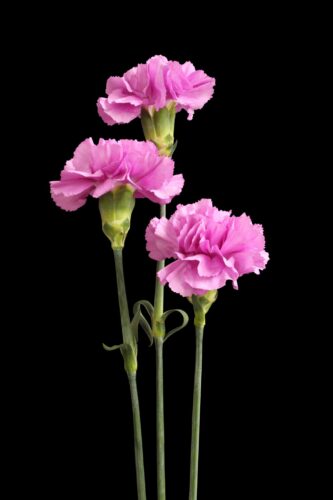Spain’s national flower is the red carnation, symbolizing love, admiration, and respect. The red carnation holds special significance in Spain’s culture and traditions, often used in festivals, celebrations, and religious events.
Its vibrant color and delicate fragrance have made it a popular choice for bouquets, decorations, and gifts in Spanish society. The red carnation also has historical and political associations, representing different movements and ideologies throughout Spain’s history. With its rich symbolism and widespread use, the red carnation continues to be a beloved and iconic flower in Spain, capturing the essence of the country’s passion and heritage.
History Of The Red Carnation
The Red Carnation, Spain’s national flower, has a rich history deeply intertwined with the country’s culture and traditions.
Origins Of The Red Carnation
Legend has it that the red carnation first bloomed where the Virgin Mary shed tears, symbolizing love and admiration.
Significance In Spanish Culture
In Spanish culture, the red carnation holds traditional significance in festivals, celebrations, and as a symbol of love and passion.

Credit: www.southernliving.com
Symbolism And Meaning
The red carnation has deep-rooted symbolism and meaning that transcends its physical beauty. Let’s explore how this iconic flower represents various aspects of human emotions and national significance.
Love And Romance
In romantic contexts, the red carnation symbolizes passionate love and admiration towards a significant other. It conveys affection and deep emotional connection in relationships.
Patriotism And National Identity
As Spain’s national flower, the red carnation embodies patriotism and national pride. It symbolizes strength, courage, and unity among the Spanish people.
Cultural Significance
Spain’s national flower, the red carnation, holds immense cultural significance in the country. This beautiful flower is not just admired for its vibrant hue and delicate petals, but it also represents various aspects of Spanish culture, traditions, and literature.
Traditional Festivals And Events
The red carnation plays a prominent role in traditional festivals and events across Spain. One such example is the Feria de Abril in Seville, where both men and women adorn themselves with red carnations as a symbol of joy and celebration. It is fascinating to witness the vibrant sea of red flowers, creating a visually captivating atmosphere.
Another festival where the red carnation takes center stage is the Goyesca Bullfight in Ronda. Here, the matadors wear elegant costumes adorned with red carnations, adding a touch of flair and tradition to the event.
Art And Literature
The red carnation has inspired numerous artists throughout history, making appearances in paintings and sculptures. In Spanish literature, this flower is often used as a symbolic motif to represent love, passion, and admiration.
One notable example is the renowned Spanish playwright Federico García Lorca, who frequently incorporated the red carnation into his poetic works. His poems beautifully depict the carnation as a symbol of love and longing, adding a touch of romanticism.
Furthermore, the red carnation is immortalized in art forms such as flamenco, where dancers often wear red carnations in their hair, accentuating their movements with a touch of elegance and grace.
Overall, the red carnation is deeply ingrained in the cultural fabric of Spain. Its association with traditional festivals, art, and literature reinforces its significance as a symbol of joy, love, and pride. Whether witnessed in the vibrant streets during festivals or admired in paintings and poems, the red carnation remains an enduring symbol of Spanish heritage.

Credit: www.amazon.com
Role In Spanish Traditions
The red carnation holds a significant role in Spanish traditions and is deeply ingrained in the country’s rich cultural heritage. The flower’s vibrant hue and delicate petals are not only a symbol of beauty but also carry deep symbolism in various ceremonial aspects of Spanish life, including weddings, celebrations, and funerals.
Weddings And Celebrations
Red carnations are widely used in Spanish weddings and other joyous celebrations. The striking color of the carnation represents love, passion, and admiration, making it a popular choice for adorning the bride’s bouquet or adding a touch of elegance to the decorative arrangements.
Funerals And Mourning
Contrary to its association with celebrations, red carnations also hold a significant place in Spanish funeral customs. The deep crimson color symbolizes respect and affection for the departed. It is common to see red carnations adorning caskets or used as a gesture of sympathy and remembrance.
Role In Religious Ceremonies
Spain’s national flower, the red carnation, holds significant cultural importance, particularly in religious ceremonies. The flower has a rich history and plays a meaningful role in several religious festivals and events.
Easter And Holy Week
The red carnation is a symbol of love, sacrifice, and resurrection, making it a fitting choice for Easter and Holy Week celebrations in Spain. It is often used to decorate altars, homes, and processional routes during these religious observances, signifying the deep faith and reverence of the Spanish people.
Our Lady Of Carmen Festival
During the Our Lady of Carmen Festival, the red carnation takes on a special significance. It is customary for devotees to offer bouquets of red carnations to the patron saint, symbolizing their devotion and seeking blessings for protection and guidance. This tradition showcases the enduring spiritual connection between the red carnation and religious practices in Spain.
Red Carnation As A National Symbol
The vibrant and captivating red carnation holds a special place in the hearts of the Spanish people as it proudly represents Spain as its national flower. With its enchanting beauty and rich historical significance, the red carnation symbolizes deep-rooted cultural values and traditions that have been embraced by generations of Spaniards.
Official Adoption By Spain
In the year 2001, the Spanish government officially recognized the red carnation as the national flower of Spain. This declaration was made to honor the flower’s symbolism and association with the Spanish heritage and national identity. The red carnation’s selection was a well-thought-out decision, given its historical significance and widespread popularity across the country.
Use In Government And Politics
The red carnation’s significance extends beyond its aesthetic appeal and cultural representation. It has also found its place in the realm of Spanish government and politics. The flower is often utilized to signify support during elections, political rallies, and national celebrations. It serves as a symbol of unity, pride, and solidarity, bringing people together in their shared love for Spain.
Furthermore, the red carnation has been used by politicians to communicate their stance on various issues. By wearing or presenting a red carnation, politicians can convey their commitment to the Spanish people and their dedication to upholding the values and ideals synonymous with the national flower.
It is not uncommon to witness politicians, both in Spain and abroad, incorporating the red carnation into their attire during official events or public appearances. This powerful visual statement reinforces their connection to the Spanish culture and their desire to work towards the betterment of the nation and its people.
In conclusion, the red carnation holds a significant place in Spanish society, serving as a cherished national symbol. Its official adoption and its prominent use in government and politics highlight its importance in unifying the Spanish people and embodying the values and spirit of Spain.
Varieties And Cultivation
When it comes to the varieties and cultivation of the red carnation, there is a rich history and symbolism associated with this iconic flower. Red carnations are known for their vibrant color and strong fragrance, making them a popular choice for various occasions.
Different Types Of Red Carnations
- Standard Red: Classic deep red hue, symbolizing love and admiration.
- Dark Red: Intense and velvety, signifying deep affection and passion.
- Light Red: Soft and delicate, representing admiration and gratitude.
Growing And Caring For Carnations
To grow healthy red carnations, provide well-drained soil, ample sunlight, and regular watering. Avoid overwatering to prevent root rot.
- Planting: Choose a sunny location with fertile soil.
- Watering: Keep the soil moist but not waterlogged.
- Fertilizing: Use a balanced fertilizer to promote blooming.
- Pruning: Trim faded flowers to encourage new growth.
| Aspect | Care Tips |
|---|---|
| Soil | Well-drained, fertile soil is essential. |
| Sunlight | Require at least 6 hours of sunlight daily. |
| Watering | Keep soil consistently moist but not soggy. |
With the right care, red carnations can thrive and bloom abundantly, adding beauty and charm to any garden or floral arrangement.
Interesting Facts And Trivia
Throughout history, the red carnation has held great significance in various cultures and traditions.
Red carnations have broken records in terms of size, color intensity, and longevity, captivating flower enthusiasts worldwide.
The red carnation, Spain’s national flower, carries a rich tapestry of interesting facts and trivia that make it a symbol of love, admiration, and strength.
- Red carnations are often associated with love and admiration in Spain.
- In Spanish folklore, it symbolizes passion and is frequently used in weddings and celebrations.
- Queen Isabella of Spain was known to adorn her clothing with red carnations to honor fallen soldiers.
- During the Spanish Civil War, the red carnation became a symbol of resistance and unity among the people.
- The red color of the carnation symbolizes strength and bravery in the face of adversity.
| Fact | Detail |
|---|---|
| Origin | Red carnations are native to the Mediterranean region and have been cultivated for over 2,000 years. |
| Symbolism | In Christian tradition, the red carnation symbolizes the blood of Christ and is often associated with martyrdom. |
| Cultural Significance | In Spain, the red carnation is a symbol of good luck and is often worn during festivals and bullfights. |
| Historical Significance | During the Renaissance era, red carnations were highly prized for their fragrant essence and vibrant color. |
The red carnation’s enduring popularity and cultural significance make it a timeless emblem of love, passion, and resilience.

Credit: gift.lovingly.com
Frequently Asked Questions Of Spain’s National Flower: The Red Carnation And Its Representations
What Is The Significance Of The Red Carnation In Spain?
The red carnation holds cultural significance in Spain, symbolizing love, admiration, and respect.
What Occasions Are The Red Carnations Commonly Associated With In Spain?
Red carnations are commonly associated with events like Mother’s Day, National Day, and religious celebrations in Spain.
Why Is The Red Carnation Considered The National Flower Of Spain?
The red carnation was chosen as Spain’s national flower due to its historical symbolism and widespread popularity in the country.
How Is The Red Carnation Traditionally Used In Spanish Culture?
In Spanish culture, red carnations are used as decorations, gifts, and symbols of honor and remembrance.
What Are The Different Meanings Associated With The Red Carnation In Spain?
The red carnation represents deep love, admiration, and affection, making it a versatile and cherished flower in Spanish culture.
Is There A Specific Historical Significance Attached To The Red Carnation In Spain?
Yes, the red carnation has historical significance in Spain, particularly during the Spanish Civil War and as a symbol of political movements.
Where Can Visitors Experience The Cultural Significance Of The Red Carnation In Spain?
Visitors can witness the cultural significance of the red carnation at festivals, ceremonies, and traditional events throughout Spain.
Conclusion
The red carnation holds a significant place in Spain’s cultural history as its national flower. Symbolizing love, passion, and strength, it has become a cherished emblem in Spanish customs and traditions. Whether adorning a flamenco dancer’s hair or displayed during national holidays, the red carnation remains a powerful representation of Spain’s vibrant heritage and rich symbolism.
Its enduring popularity and timeless beauty continue to captivate both locals and visitors alike. Discover the allure of Spain’s national flower and let it enchant your senses.
